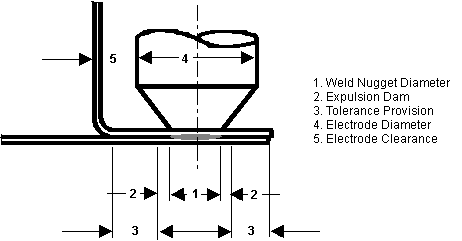Weld Flange Too Small
Definition
The width of the weld flange is inadequate to allow proper placement of the weld.
Description
Weld flange widths are subject to company standards. Minimum widths are specified such that an acceptable welding situation exists given:
- the diameter of the electrode shank
- the diameter of the tip face
- the angle of the electrode bevel
- clearance required between the electrode shank and the workpiece surfaces
- assembly tolerances
- trimming tolerances
- allowances for damming (containing) expulsion
- the gages being welded
- whether the welding is manual or automated
- whether welding is occurring in a stamping or an assembly plant
If the minimum width criterion is not satisfied, welding can be adversely affected.

Typical Components of Flange Width Specification
Detection
- Cracks and Holes
- Expulsion/Burn Through
- Mislocated/Edge Weld
- A visually obvious mismatch between flange lengths may indicate that one flange is too short.
Significance
Quality, Workplace Issues, Cost, Downtime, Maintenance, Throughput (cycle time; PPH), are all potentially affected by this condition. Special considerations are noted below:
Quality: Cracks and holes result from edge welding conditions. The electrode may be moved inboard by the manual operator or robot programmer to avoid edge welding. This will reduce the electrode clearance, thereby increasing the risk of short-circuiting the welding current through other accidental contact points. Undersized welds may result.
Workplace Issues: Heavy expulsion can result when the edge of the flange comes too close to the edge of the tip face leaving insufficient expulsion dam, or the edge of the flange is actually between the tip faces.
Cost: Tip life may be reduced by expulsion conditions. Increased care and therefore time is required of automation programmers and manual welders to avoid weld problems.
Downtime: Frequent reprogramming of robots may be required to correct for short flange conditions.
Maintenance: Increased maintenance may be required due to expulsion build-up and more frequent tip changes.
Subordinate Causes
- Short flange in stamping: improper stamping processing, die wear, etc. produces an undersized flange.
- Short flange overlap: flanges are correct length, but their overlap is reduced by relative part misplacement.

